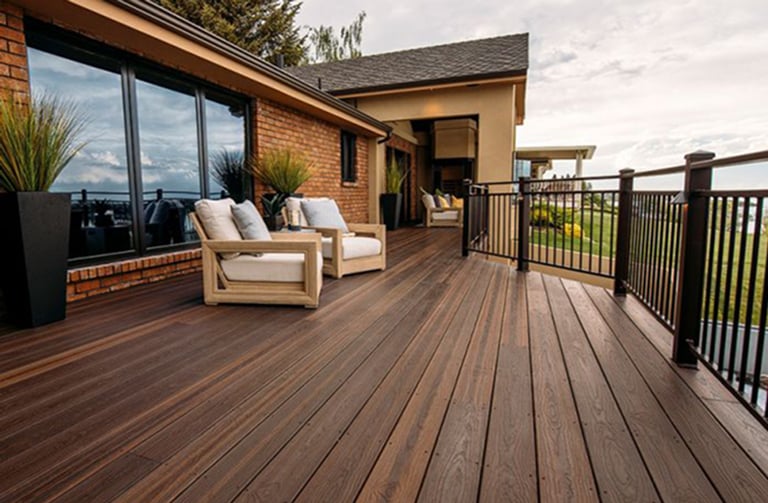Outdoor WPC (Wood-Plastic Composite) flooring represents a cutting-edge solution for enhancing outdoor spaces. It combines the natural appeal of wood with the durability of plastic, creating an attractive and resilient surface suitable for various outdoor applications. Whether you’re looking to revamp your deck, patio, or other outdoor areas, outdoor WPC flooring offers numerous advantages, including weather resistance, low maintenance, and a wide range of design options. In this blog, we’ll explore the world of outdoor WPC flooring, delving into its key features, benefits, installation process, and more, to help you make an informed choice when transforming your outdoor living spaces.
What is Outdoor WPC Flooring?
Outdoor WPC flooring is a versatile and innovative decking material designed specifically for outdoor use. It is composed of a blend of wood fibers or wood flour and plastic polymers, creating a resilient and weather-resistant surface. This type of flooring is engineered to withstand the harsh outdoor elements, making it ideal for various applications, including:
Decks: Outdoor WPC flooring is commonly used to replace traditional wood decking due to its durability and low maintenance.
Patios: It provides an attractive and long-lasting surface for patios and outdoor seating areas.
Balconies: WPC flooring can transform balconies into inviting spaces with the look of natural wood without the maintenance hassles.
Pool Decks: Its resistance to moisture and slipping makes it a popular choice for poolside decking.
Gardens: WPC flooring can be used for garden pathways, adding both functionality and aesthetic appeal.
Key characteristics of outdoor WPC flooring include its ability to withstand moisture, UV rays, and temperature fluctuations while maintaining its appearance and integrity. It is available in a variety of styles, colors, and textures, often mimicking the look of wood or other natural materials. Outdoor WPC flooring offers a balance between aesthetics and practicality, making it an excellent choice for those seeking durable and visually appealing outdoor surfaces.
Difference between WPC, SPC, and traditional hardwood flooring.
WPC (Wood-Plastic Composite) Flooring:
- Composition: WPC flooring is made from a blend of wood fibers or wood flour and plastic polymers, creating a composite material. It may also incorporate other materials for added durability.
- Water Resistance: WPC is typically water-resistant or waterproof, making it suitable for moisture-prone areas like bathrooms and kitchens.
- Durability: WPC is highly durable and resistant to wear, scratches, and dents. It can handle high-traffic areas with ease.
- Maintenance: It is easy to clean and requires minimal maintenance. Regular sweeping and occasional mopping are usually sufficient.
- Installation: WPC often features DIY-friendly installation methods like click-lock systems, reducing installation costs.
SPC (Stone-Plastic Composite) Flooring:
- Composition: SPC flooring is composed of natural stone dust and plastic polymers, resulting in a dense and rigid core layer.
- Water Resistance: SPC is waterproof, offering exceptional resistance to moisture and water damage.
- Durability: SPC is highly durable and can withstand heavy use, making it suitable for both residential and commercial spaces.
- Thin Profile: SPC planks are thinner than WPC and hardwood, which can be advantageous when transitioning between different flooring types.
- Installation: SPC often features click-lock or glue-down installation methods, providing installation flexibility.
Traditional Hardwood Flooring:
- Composition: Hardwood flooring is made from natural wood, usually solid hardwood or engineered wood with a real wood veneer.
- Water Resistance: Hardwood is susceptible to water damage and should not be installed in areas with high moisture levels.
- Durability: While hardwood is durable and can last for generations with proper care, it can be prone to scratches, dents, and wear over time.
- Maintenance: Hardwood requires regular maintenance, including refinishing to maintain its appearance.
- Installation: Hardwood installation is typically more labor-intensive and may require professional installation. It is not ideal for DIY projects.
In summary, WPC and SPC flooring offer enhanced water resistance, durability, and ease of maintenance compared to traditional hardwood flooring. They are suitable for various environments, including those with moisture concerns. On the other hand, hardwood flooring provides a timeless and authentic look but requires more maintenance and may not be suitable for all areas due to its susceptibility to moisture damage. The choice between these flooring types depends on factors such as budget, design preferences, and the specific needs of the space.
Advantages and Disadvantages of Outdoor WPC Flooring
Advantages of Outdoor WPC Flooring:
Weather Resistance: Outdoor WPC flooring is designed to withstand harsh weather conditions, including rain, snow, and intense sunlight, without warping, cracking, or fading.
Durability: It is highly durable and can handle heavy foot traffic, making it suitable for areas like decks, patios, and poolside.
Low Maintenance: WPC requires minimal maintenance compared to traditional wood decking. Regular cleaning with soap and water is usually sufficient.
Waterproof: Many outdoor WPC options are waterproof, preventing water damage and decay often associated with natural wood.
Aesthetic Variety: Outdoor WPC comes in a wide range of styles, colors, and textures, allowing for diverse design possibilities to suit your outdoor space.
Environmentally Friendly: It often incorporates recycled materials and reduces the demand for virgin wood, contributing to sustainability efforts.
Comfortable Underfoot: WPC has a comfortable and slightly soft feel underfoot, making it pleasant to walk on barefoot.
Disadvantages of Outdoor WPC Flooring:
Cost: Outdoor WPC flooring can be more expensive upfront than some traditional decking materials like pressure-treated wood.
Limited Repair Options: Unlike wood, which can be sanded and refinished, WPC planks cannot be refinished, so damaged sections may need to be replaced entirely.
Heat Retention: In extremely hot weather, some WPC surfaces may become warm to the touch, potentially uncomfortable for bare feet.
Appearance Over Time: While it maintains its appearance well, some fading or color changes may occur with prolonged exposure to direct sunlight.
Environmental Concerns: Although more eco-friendly than some alternatives, WPC is still a synthetic material and not as sustainable as natural wood.
Weight: WPC can be heavier than other materials, which can be a consideration for upper-level installations or older structures.
In summary, outdoor WPC flooring offers several advantages, including weather resistance, durability, and low maintenance. However, it comes with some drawbacks, such as cost and limited repair options. Choosing outdoor WPC flooring depends on your specific needs, budget, and preferences for your outdoor space.
What is the most waterproof type of Outdoor WPC flooring?
The most waterproof type of outdoor WPC (Wood-Plastic Composite) flooring is typically labeled as “waterproof” or “100% waterproof” WPC flooring. This designation indicates that the flooring has undergone additional treatments or features a specialized construction that provides an extremely high level of water resistance.
Here are some key features to look for in the most waterproof outdoor WPC flooring:
- Waterproof Core: The core layer of the flooring should be composed of a waterproof material, often referred to as an “impervious core” or “waterproof core.” This core prevents water from penetrating and damaging the planks.
- Tight Interlocking Mechanism: High-quality waterproof WPC flooring features a secure and tight click-and-lock or interlocking system that leaves no gaps for water to seep through.
- Sealed Edges: Some waterproof WPC planks have specially sealed edges that provide an extra layer of protection against moisture.
- Waterproof Surface Layer: The top wear layer should also be waterproof or highly water-resistant to ensure complete protection from spills and moisture.
- Underlayment Compatibility: Consider using a waterproof underlayment or moisture barrier during installation to further enhance water resistance.
- Manufacturer’s Specifications: Always check the manufacturer’s specifications and product descriptions to verify the level of waterproofing. Look for products that explicitly state their waterproof capabilities.
It’s important to note that while waterproof WPC flooring is highly resistant to moisture, proper installation and maintenance are still crucial to ensure its long-term performance. Additionally, be aware that product quality can vary between manufacturers, so it’s advisable to choose a reputable brand known for its waterproof outdoor WPC flooring options to guarantee the best results in wet outdoor environments.
Does WPC flooring scratch easily?
WPC (Wood-Plastic Composite) flooring is known for its durability and resistance to scratches, but it is not completely scratch-proof. Its susceptibility to scratching can vary depending on several factors:
Wear Layer Thickness: WPC flooring typically features a wear layer on the surface, which provides protection against scratches and wear. The thickness of this wear layer varies among different WPC products. Thicker wear layers are generally more scratch-resistant.
Quality of the Product: The quality of the WPC flooring matters. Higher-quality products often have more robust wear layers and better scratch resistance.
Protective Measures: While WPC is resistant to scratches from everyday activities like walking or moving furniture, sharp or heavy objects can still potentially cause damage. Using furniture pads, area rugs, and taking precautions when moving heavy items can help prevent scratches.
Maintenance: Regular maintenance, such as sweeping and damp mopping, can help keep the flooring clean and minimize the appearance of scratches.
Pets: If you have pets with sharp claws, they can potentially scratch the surface over time. Keeping pets’ claws trimmed and using pet-friendly rugs or mats in high-traffic pet areas can help.
Use of Furniture: Heavy furniture or appliances with sharp edges can scratch the surface if not adequately protected. Be cautious when moving such items and use furniture pads.
Conclusion
Outdoor WPC (Wood-Plastic Composite) flooring represents a revolution in outdoor surface solutions, combining the timeless beauty of wood with modern technology. Engineered to withstand the harshest outdoor conditions, it offers a myriad of advantages. Its weather-resistant properties make it impervious to rain, snow, and the damaging effects of UV rays. Unlike traditional wood, outdoor WPC flooring doesn’t warp, crack, or splinter, ensuring long-lasting durability. Its low-maintenance nature means you can spend more time enjoying your outdoor space and less time on upkeep.
Moreover, outdoor WPC flooring comes in an array of styles, colors, and textures, allowing for versatile design options that suit your aesthetic preferences. Whether you’re creating a welcoming deck, a stylish patio, or a relaxing poolside area, WPC flooring offers the perfect blend of form and function. It’s an eco-friendly choice, often incorporating recycled materials, contributing to sustainable living. In summary, outdoor WPC flooring is a game-changer for outdoor spaces, providing beauty, resilience, and ease of use in one impressive package.




